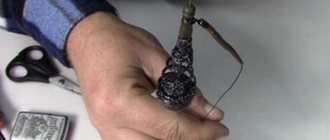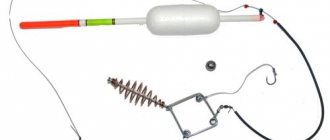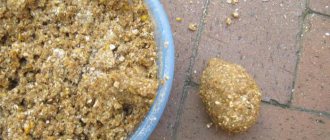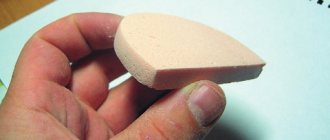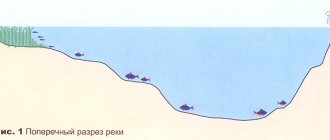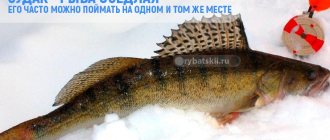Preparing skimmers for sludge
In fishing parlance, scoops for removing crushed ice and snow from a hole began to be called skimmers when it was unknown. It is likely that this happened in those days when skimmers took a place in the kitchen of all housewives.
First time on the ice. Photo: Andrey Yanshevsky.
One way or another, the nickname has been preserved, despite the fact that almost no one uses skimmers for soup when fishing anymore.
The reason is that it turns out to be expensive. A soup slotted spoon does not last long when fishing; the handle flies off after several hits on the edge of the hole.
It should be noted that fishermen are divided into those who do not go fishing without a scoop, and those for whom this tool is not necessary.
It all depends on the method of winter fishing. A scoop is absolutely necessary when fishing with float tackle and with jigs. Moreover, in float fishing, a slotted spoon is constantly used so that bites are visible. When fishing with girders, a scoop is needed to clean the hole before installing live bait gear, as well as to cover the hole with a girder equipped with a layer of snow.
Later, if a predator bites, you will need a scoop to clean the hole and observe the behavior of the pike or pike perch under the hole. Taking a predator with a hook if you can’t see its head is quite problematic.
When fishing with a jig, and especially with a spinner, you can get by without a scoop if the frost is below minus ten to twelve degrees.
The hole needs to be cleaned only once, immediately after it is drilled. The worst way to clean a hole is to “pump” it with an ice drill. There is a lot of noise, to which only small perch are calm.
The easiest way to clear the hole so that you can easily drop a small bait into it is to use a boot.
To do this, you need to stick the nose of the boot into the hole and pull it out sharply. The water will raise the ice and you need to have time to kick it to the side. The lower slush will rise, that is, float up, and the action is repeated. After a couple of times, that is, after a few seconds, you can catch. In frosty weather, a slotted spoon is used to chip away the ice that freezes in the hole, so as not to make noise with an ice screw.
You can break freezing ice with a dry twig.
Many fishermen use a twig to make a central hole in the slush in a hole that has been drilled and not completely cleaned, so that the jig can pass through it.
From my own experience, I can say that it is not critical for me if the scoop is left at home, lost or broken while fishing. There is a hand that will not freeze in water with temperatures above zero. But after bathing, you need to wipe your hand with a dry cloth, which in any case should be in your pocket. At least in order to wipe the same hand from the “snot” of a bream or roach.
Scoops come in metal and plastic. Both have their advantages and disadvantages.
Metal scoops are good if you need to chip away ice that gradually builds up along the edges of the hole; they are strong and durable.
In a good scoop, the working plane with holes is welded, not by spot welding, but by a seam to the central rod. One of the surfaces is either sharpened or serrated to make it easier to chip ice.
Notch for chipping ice on the edge of the hole. Photo: Andrey Yanshevsky.
Metal scoops have a tendency to slip away from the angler into the hole and sink. Therefore, the best scoops have handles made of wood or rigid foam that have sufficient buoyancy.
The cork handle prevents the skimmer from sinking. Photo: Andrey Yanshevsky.
Plastic scoops are good because they are lightweight, ice practically does not freeze on them, and if it does freeze, then a light blow is enough and the ice will fly off. But they fail to break off ice from an ice drill. Plastic, especially in cold weather, requires a more delicate attitude.
Anglers’ attitude towards hooks and hooks is not as clear as towards skimmers. Almost everyone has them, but they don’t always take them fishing and are often forgotten even when going after a predator. The exceptions are bream hunters and, of course, garrison fish.
I believe that a hook is absolutely necessary for winter fishing, even more necessary than in summer. And not because larger fish are caught in winter, but because you can easily remove only pike up to a kilogram, and bream up to seven hundred grams, from a hole with a diameter of 130 mm without the help of a hook.
Larger specimens, of course, can be recovered, but there are a lot of failures right next to the hole. And large fish, by city standards, are not found very often.
Many fishermen simply resign themselves to the fact that any pike weighing more than three kilograms accidentally caught on the bait is lost.
Most fishermen do not rely on their skill in catching large fish, but on the fact that if they suddenly come across a specimen that does not fit into the hole, their neighbors will help. After all, someone must have a hook!
But, if you are determined to catch big fish purposefully, then you need to have your own hook with you. And always, no matter what body of water you are going to fish on.
As an example, I will say that even within the boundaries of Moscow, in the Khimki Reservoir or in the Stroginskaya floodplain, catches of roach up to a kilogram, bream up to two kilograms, three kilogram pike perches and kilogram perches still happen.
Some anglers go a different route. They choose ice screws with a deliberately large diameter. This activity reminds me of morning exercises and jogging.
Why bother with the useless crushing of ice when it is easier to have a gaff. In addition, the larger the hole, the more noise, the more light passes under the ice and the further the fish moves away from the hole.
The time before a bite increases significantly, and the winter days are short.
A very controversial question is which hook is better in design. Many people think that it should be telescopic. But, the rods of such hooks tend to fold or rotate while the fish is catching.
For myself, I came to the conclusion that a collapsible rod 80 cm long, in which three components are connected by thread, is better. Foam handle.
For pike, the hook size is 40 mm. Personal practice shows that a hook of this size catches and holds both a half-kilogram bream and a nine-kilogram pike equally well.
For trout, muksun, sturgeon, bream, large roach, I have a different hook. Instead of a single hook, I soldered a high-quality tee from a spinner, which is easy to hook fidgety but not too heavy fish.
Hook for small fish. Photo: Andrey Yanshevsky
A rope loop must be attached to the handle of the hook. It is not needed in order not to accidentally miss the hook into the hole. It happens that a large pike has already been brought to the hole, but it is not possible to turn it head up. As soon as you start to pull up, another jerk follows.
In order not to take risks and not rely on the strength of the leash, you have to grab the fish under the belly. And what to do after that?
Durable do-it-yourself ice fishing scoop
If we begin to list the elements of equipment for ice fishing in order of necessity, then the scoop is located immediately after the ice auger; you can do without a scoop just as much as you can do without an auger, without specialized clothing, without a box, in other words, you can - but it’s better when you have one. The scoop, despite its primitive design, must have a number of characteristics, namely: not freeze, have sufficient strength to break the edges of the hole and not sink. As a rule, the ice of the drill is also knocked off with a scoop; you can also do this with a mallet, but after some time of fishing I came to the conclusion that it is still more convenient to do this with a scoop. And so, from the moment I started fishing in winter, the modernization of scoops began. The ice on the scoop, which builds up with each dive, should be knocked off every time, but this is not always convenient, and when the scoop is already frozen well, I knock off the ice with one blow on the ice, chair, drill... Not a single store-bought scoop could withstand such a blow, the spoon flew off , the handle broke in half, the handle flew off, bent 360 degrees))) And when the spoon of the scoop once again flew off while fishing at -25 with a wild wind, I decided to make my own scoop that would not freeze too much, was strong and rigid and at the same time light .
The Tonar scoop was used as a basis; the wooden handle, which constantly froze, was replaced with an aluminum handle of suitable length. The attachment to the spoon was made using two screws (so that the spoon would not rotate along the axis of the screw); to avoid loosening, the nuts installed through the screw were additionally sealed. The hole in the tube from the bottom is filled with silicone glue. There is no need for a warm handle on the scoop, you only need a handle so that the metal does not burn your hands, electrical tape also does this well.
The mass of the scoop turned out to be less than titanium with the same dimensions (luminum is almost twice as light as titanium). The low adhesive ability of aluminum almost does not collect water and therefore almost does not freeze; slight icing of the scoop, due to the high hardness of the materials, falls off even with gentle tapping, which cannot be said about scoops with wooden handles. So that the scoop would not be lost, would not drown, and would always be at hand, I attached it to the chair with the help of a retriever (now a very common phrase I hear when fishing is “look, the scoop is tied”)))))).
A crash test of the scoop showed its very high strength: you can hit with all your heart, chop ice in a hole of any thickness, beat off frozen screws, you can clean the hole in mittens without fear of drowning it, when you release the scoop, the retriever pulls it strictly under the chair and now you don’t need to look where I last threw the ladle.
What it is?
This fishing “skimmer” can be used even in ways that you wouldn’t immediately guess:
- the most common application is to clean the hole from slush: fine, loose ice that forms in cold water - this must be done regularly, otherwise this looseness will freeze on the fishing line, the float, if there is one, and completely fill the hole;
- you have to use a scoop when landing large trophy fish, knocking down the edges of the hole and removing snow;
- It happens that a fisherman uses several holes at once, which gradually freeze - thin ice can also be conveniently broken with a scoop;
- It’s more convenient for them to pull the fry out of the tanks where they are kept as live bait - it’s not very comfortable to do this with your hands in the cold;
- Ice often forms on ice screws; experienced fishermen use special wooden mallets to knock it down, but you can also use a fishing slotted spoon, which will do just fine.
Is it possible to do without a slotted spoon?
There are many recommendations that seem to allow you to do without a ladle. There are quite constructive ones:
- if your ice drill makes a hole with a diameter of 130 mm, and your fishing neighbor has 100 mm in diameter, cooperate: first drill 130 mm, and drill 100 mm deeper, the difference in diameter will prevent the bottom layer from freezing;
- when fishing in a tent, sometimes they heat water in a mug with a heater or burner and pour boiling water into the hole - it helps for a while;
- the tent itself, if it is tightly closed, can prevent the hole from freezing for a long time;
- if the drilled hole is not going to be used for some time, it can be covered with a pre-prepared circle of polystyrene foam.
It turns out that a scoop is the simplest and most inexpensive solution. Spend once and you can spend the whole winter without any hassle.
There are several options for these products. Each has its own advantages and disadvantages.
Metal
The most common type. It has many advantages:
- such scoops are the most durable;
- they are convenient to use as a percussion instrument;
- A true fishing scoop has serrations on the outside to break ice.
Reticulate
With such scoops, water flows down faster, less sludge is sifted, and they are lighter. They are more convenient for catching fry. But chipping the ice is already problematic.
Plus, in terms of strength, products with metal mesh are clearly inferior to all-metal ones. You can simply step on them carelessly. And these scoops also sink, so they are less popular.
Plastic
The lightest option in terms of weight. It quickly gets rid of sludge and does not freeze. Easily visible on white snow, rarely lost, as it is painted in bright colors. However, they won’t be able to chip ice efficiently either. And in terms of strength, this product is much inferior to the previous ones.
Kinds
There are several options for these products. Each has its own advantages and disadvantages.
Metal
The most common type. It has many advantages:
- such scoops are the most durable;
- they are convenient to use as a percussion instrument;
- A true fishing scoop has serrations on the outside to break ice.
Expert opinion
Knipovich Nikolai Mikhailovich
Zoologist, hydrobiologist. I am interested in fishing at a professional level.
However, metal scoops have a major, almost inevitable drawback - they sink. The trouble, however, can be eliminated by equipping the equipment with a rope worn on the hand, or by purchasing an item with a floating handle. But this possibility is often remembered only when the scoop dives to the bottom.
Reticulate
With such scoops, water flows down faster, less sludge is sifted, and they are lighter. They are more convenient for catching fry. But chipping the ice is already problematic.
Plus, in terms of strength, products with metal mesh are clearly inferior to all-metal ones. You can simply step on them carelessly. And these scoops also sink, so they are less popular.
Plastic
The lightest option in terms of weight. It quickly gets rid of sludge and does not freeze. Easily visible on white snow, rarely lost, as it is painted in bright colors. However, they won’t be able to chip ice efficiently either. And in terms of strength, this product is much inferior to the previous ones.
How to choose?
But the manufacturing method is not the whole choice. There are other criteria.
By shape
And here are the subtleties:
- round - the most common, ideal for the same holes, usually their diameter is smaller than the diameter of the ice drill;
- elongated - have a slightly pear-shaped shape, are rare, but many consider them more convenient than round ones;
- square - they are convenient not only for scooping up slush, but also for getting bait caught on the ice.
Some fishermen carry square scoops just for this purpose. Only choose models with long handles.
By handle
The metal handle in such factory equipment has not been used for a long time. There are other materials on which frost has little effect:
- ordinary wooden;
- from foam plastic;
- cork
The latter are inferior to the first two in strength, but attract with lightness and size.
For different types of fishing
You don’t have to take this equipment at all if you go fishing with a jig or when trolling vertically. The active behavior of the fisherman above the hole and manipulating the fishing rod will simply not allow sludge to form. It is enough to release the water once after drilling, even with the help of an ice drill. True, this noise will put the fish off for some time. But in other cases it is difficult to do without a scoop:
- with a float rod, you may not notice the bite at all, the float will remain motionless even in the first layer of still unnoticeable ice;
- You also need a winter slotted spoon when catching predatory fish on girders;
- the same is necessary when fishing for a trophy using a hook.
This slotted spoon is convenient for removing snow from the edge of the ice, especially in windy weather. You can’t do without it even when using several holes.
Titanium is a reliable material of manufacture
Metal, mesh and plastic scoops have already been discussed above. Recently, two more materials have appeared that are already taking leading positions in sales: stainless steel and titanium. Both options are not subject to corrosion. But titanium products also have other advantageous features:
- they do not drown in water;
- with a diameter of 90 mm, such a scoop weighs only 120 g;
- titanium is an elastic material, so scoops made from it are made deeper;
- They are easily cleared of ice by simply tapping the boot.
How to make a slotted spoon with your own hands without a drawing?
Some people upgrade a kitchen slotted spoon of the required diameter by attaching a wooden handle to it instead of a metal one. There are options when notches are made in the metal saucer of such a slotted spoon for chopping ice. Craftsmen use soft aluminum.
But the option below looks especially attractive against the backdrop of clearly non-budget titanium structures.
Tools:
Materials:
- plastic lid for the jar;
- screw;
- nail;
- any bright paint;
- wooden stick 30 - 40 cm long;
- the rope is similar in size to that found on typical ski poles.
Manufacturing instructions:
- in a regular plastic lid, use a nail to punch the required number of holes;
- select a stick of suitable length;
- it is drilled to the edge of the lid;
- a rope is attached to the free end of the stick, like a ski pole, for ease of carrying or getting out of the water;
- The stick can be painted with bright paint so that it is visible in the snow, but the lid does not need to be painted so as not to scare the fish in the water.
DIY ice fishing scoop!
Show the user interface buttons
- Published 21 Lute 2020
- You can easily make a scoop for winter fishing with your own hands, all you need is a frying pan and a desire to make things! My scoop turned out to be light - only 110 grams, diameter 11.5 cm, and length 33 cm. I made such a useful homemade product from unnecessary trash! Everything for Fishing with Ali: ali.pub/2xys72 Video camera: YI 4 K: ali.pub/29su63 I’m on VK: id70892591 Practical parades and style
I advise you to install a third rivet; it will be safer to screw the second screw into the handle! Good luck.
Manufacturing technology
To make a homemade tool, you need to select the following materials:
- wooden handle for a shovel;
- old rasp or file;
- a piece of thick-walled pipe with an internal diameter of about 40 mm;
- screws or nails;
- strong belt or rope.
The most difficult operation seems to me to be the creation of a metal pointed tip.
- To do this, you need to use emery to give the file the required blade shape and do a preliminary one-sided sharpening. The final sharpening should be carried out using a small stone and a block.
- After this, the second end of the file is connected to a pipe 25-30 cm long by welding. In the upper section of the pipe it is necessary to make a hole with a diameter of 3-5 mm for a self-tapping screw or nail. In order for the metal element of the pick to look presentable and not rust, the surface is cleaned of dirt, degreased and painted.
- The handle is adjusted to the height of the fisherman using a hacksaw, and a through hole is made in the area of the handle for a strap or rope. In the future, it is advisable to cover the wooden part with stain or impregnation, and then with a layer of varnish.
- At the assembly stage, the metal tip is connected to the handle and fixed with a self-tapping screw. A rope is passed through the hole in the handle and tied in the form of a ring. Its diameter is selected according to the parameters of the fisherman’s hand.
However, a small modification to the existing skimmer can turn it into a universal tool that can easily destroy the ice crust.
Communities › Hunting and Fishing › Blog › Do-it-yourself sap for winter fishing)
The weekend is approaching, which means a trip to Baikal for the next trophies...) And then I realize that I have a juice. which I used for more than 5 years - became unusable! How come - a fisherman is a mess without a juice! I sat and thought)) I have to do it) I took a metal ring and welded a piece of tube (whichever came to hand). because I was at work - and had a free minute (in my case - 3 hours of working time) may the employer forgive me)))) I started weaving - 2 copies were made) they differed only in the cell. One sap turned out to have a smaller cell. And I tried to weave the other with a larger one!) Well, a few photos of this process) and how we went)
Tags: fishing, Baikal, perch, pike
Comments 20
did great. and if you’re not lazy and drill holes for the wire, it will work longer and you’ll be able to tap the ice. the wire will not break
there was such an idea)) but as practice has shown, over time nichrome begins to break in any case. so with holes or without holes) it will last two or three seasons, and then God forbid) and then I’ll make another one)
I had a turner sharpen a 6mm ring dia. from a sheet. 90mm wide 12mm it has 1.2mm holes around the perimeter (dimensions from memory). It worked out great; I calmly broke frozen holes with it. it was stolen while fishing (((worked fine for 5 years!
It’s like that! And even while fishing. !I would tear my head off for my weight))
If I knew who I would have torn off... I came to the hole and there was no juice. on the ice, like in a stadium, people didn’t even pay attention.
yeah, it could have been thinner and smaller) but since the ice builds up on the hole quickly and hard! I decided to do it thoroughly) so as not to be afraid to crush the ice)
It turned out well, the tube could have been smaller, but there is a plus it will be stronger!
Is it possible to tie a loop by pulling the entire wire through another loop?
yes absolutely true! so that the nichrome wire does not bend, I weave it in three approaches. i.e. three pieces of wire. it took about 3 meters.
Oh, so this is nichrome. I just tried to weave something similar from 0.8mm stainless steel and realized that I would have to weave for a week, the wire was too stiff. As a result, I fish with a kitchen slotted spoon!
well, the kitchen is for amateurs) sorry) but it’s so - inconvenient! (just right for the kitchen) and nichrome bends very well) the main thing is not to bend it)
There the question was either with a slotted spoon, or even scooping with your hands :-) Well, something took root, it’s been traveling with me for three years, although it has been modernized, a removable handle from a Chinese shovel ax has been welded on. I’ll have to try to weave it again sometime.
nichrome wire would be woven for me without any problems!)
Alas, but there is an unnecessary 5 kg of stainless steel :-) The bay is tangled, it is not possible now to wind a welding reel onto a welding reel, I go around tearing off a piece on a clamp, then on some other crap. Even who the hell knows where it is sold, I never was interested.
I also somehow didn’t wonder where it was sold) I got it from my father-in-law (he gave me 20 meters for hinges) also here and there, the freebie is over ((
RADIO PARTS at the elevator))) And you were lucky with your father-in-law))) you gave so much nichrome)))
no, you're lucky))) And you)))) good man!)
RADIO PARTS at the elevator))) And you were lucky with your father-in-law))) you gave so much nichrome)))
Choosing a scoop for winter fishing
A scoop, or slotted spoon, is one of the most useful tools for ice fishing. Its main purpose is to remove slush (ice fragments) from the holes. But its scope of application is not limited to this. Fishermen are divided into those for whom a scoop is a must, and those who can do without it. It is not needed in all types of ice fishing. The stores have a large selection of scoops designed specifically for fishing. You can also use regular kitchen skimmers, although they have disadvantages compared to models designed specifically for ice fishing. Choosing the right scoop for winter fishing: let's look at the main types of such tools and figure out what to look for when buying and how you can modify the purchased skimmer yourself.
DIY ice fishing scoop!
Oynatyshty baskar elementerin corset
Slot machines
- Zhariyaland 2021 21 AKp.
- You can easily make a scoop for winter fishing with your own hands, all you need is a frying pan and a desire to make things! My scoop turned out to be light - only 110 grams, diameter 11.5 cm, and length 33 cm. I made such a useful homemade product from unnecessary trash! Everything for Fishing with Ali: ali.pub/2xys72 Video camera: YI 4K: ali.pub/29su63 I’m on VK: id70892591
- Same style
I did something like this a couple of years ago. the weak point turned out to be the place where the plate is attached to the handle; the aluminum is too soft, then I converted it to an iron rod and a file handle
What is a scoop used for?
To choose an ice fishing scoop that is right for you, the first thing you need to do is decide for what purpose you are going to use it.
- The main purpose of the scoop is to remove slush from a freshly drilled hole so that it does not interfere with fishing and does not freeze. Once this is done, you can comfortably fish in a clean hole or sprinkle it with snow if camouflage is needed. The latter is especially important when catching cautious fish at shallow depths.
- They also use a scoop to remove sludge or snow from the hole when fishing for fish, so that they do not interfere with pulling out the trophy. For example, if there is a large predator on the hook that needs to be grabbed with a hook, hooking it without seeing what is happening under water is quite problematic. This is where a ladle comes in handy.
- Sometimes you have to use a slotted spoon to remove ice from an already frozen hole. This happens if fishing involves fishing in a circle of several points, as well as when fishing for girders.
- Another purpose of the scoop is to knock ice off the ice auger blades. To do this, it is best to use a special wooden mallet, with which you can quickly tap the ice without damaging the instrument. But few people take such beaters with them when fishing, and almost everyone has scoops.
- You can also use a slotted spoon to catch live bait from eland. This is much more convenient than reaching into a container of water with your hands in the cold.
Understanding for what purpose the tool is intended to be used, you can choose the right ice fishing scoop according to its design. To break through ice that has formed on the surface of the water, or to tap ice from an ice drill, you need strong skimmers that can withstand such loads. If you only need to remove slush or catch live bait, more flimsy scoops will do.
When used for fishing, soup skimmers can quickly become unusable. Most often, it’s because their handles fly off. True, such troubles often occur with scoops that seem to be of high quality at first glance, designed specifically for fishing. However, a quality tool that is designed specifically for ice fishing will work better than kitchen utensils.
How to Make a Scoop for Ice Fishing
Find a place where the collection of polypropylene waste is well organized. see contacts on the website pages https://1-top.ru/.
Scoop on exciting winter fishing. This is not the most basic, but also a very suitable thing. And so, by drilling through the ice with an ice drill, you can send out the ice slush by simply pumping the hole, i.e. its sharp lowering and pulling out. And so in this case, in two or three such movements, there is an option to get rid of only the ice crumble, but to make it and sell it, especially in shallow depths, prohibit it. And so noise is an option to scare wary fish.
Types of scoops
Metal stamped scoops
The cup of such a fishing scoop is a metal “saucer” with holes for water drainage. This is a classic version of the instrument that remains the most popular today.
It has significant advantages over other scoop designs:
- strength and durability: with this tool you can break ice without fear of damaging it;
- versatility: at the same time, a skimmer of this design is also well suited for catching sludge or live bait - thus, it is a universal option that can be used for any purpose.
For a high-quality scoop, the handle should be welded to the cup, and not by spot welding - welding to the central seam is needed. It’s good if there are teeth or sharpening on one of the edges of the “saucer”. This will make it easier to break the ice. You can sharpen the edge of the cup yourself.
The disadvantage of such scoops is that they sink. If you drop a tool into a hole, you can say goodbye to it forever. Therefore, it is better to choose a scoop for ice fishing of this design, equipped with a handle made of floating material. It also helps to have a loop attached to the handle that you can put over your hand.
With metal mesh
The cups of these fishing scoops consist of a metal rim on which a metal mesh is attached. A tool of this design is very convenient for scooping slush out of an unfrozen hole, as well as getting live bait from cannes.
The advantage of these scoops is that the water leaves the cup as quickly as possible. But they are inferior to stamped metal skimmers in terms of strength, so they easily become unusable if they are used to break ice formed on the surface of the hole and to tap the ice drill knives.
Like scoops with a stamped metal cup, skimmers with a metal mesh sink, so a floating handle and loop on it will be a big plus.
Plastic scoops
Every year, plastic scoops for winter fishing are becoming more and more popular. Their weight is minimal and therefore they are almost not felt in the fishing box. Also, ice almost never freezes on plastic scoops. If this does happen, it is easy to knock it down by tapping the tool on the heel or squeezing its cup.
But before you choose this option over all others and choose a plastic ice fishing scoop, you need to think carefully. You cannot break through the ice that has formed on the hole with such a tool or tap the ice drill with it. From such manipulations, plastic scoops quickly become unusable. In addition, they are not as reliable as metal ones - even if you handle such a slotted spoon carefully, it can break quite quickly. This problem is typical not only for cheap plastic scoops, but also for high-quality models from such famous companies as, for example, Rapala.
Which slotted spoon is best for winter fishing?
Now on sale you can find skimmers made of metal, plastic and mesh. Let's consider the advantages of each model.
Read! Minnow fishing
Metal skimmer
This skimmer for winter fishing is the strongest and most durable. There are holes made in its bowl to drain water. In the most durable models, the bowl is not spot welded, but is attached with a strong seam to the handle rod.
Experienced fishermen rely on models with a wooden tip on the handle. They are more convenient to use, they do not sink once in water, and are not as cold as metal. In terms of buoyancy, the products are second only to tools with a foam handle, but they are not as durable.
Tip: Don't use regular slotted spoons designed for the kitchen. They are inconvenient, their accuracy leaves much to be desired, and they lose their grip at the slightest load.
Mesh slotted spoon
The range of skimmers available on the market includes models with a metal mesh bowl. They are not as durable as purely metal tools, but for removing sludge and extracting live bait from a ditch, any of these models is suitable. The mesh of the bowl quickly allows water to pass through, which makes working with a slotted spoon convenient.
The disadvantages in this case include the fact that it is very difficult to break ice with a slotted spoon or remove ice from an ice drill. This often ends in tool failure. But scoops of this design practically do not freeze; even if ice forms, it is easily shaken off the mesh without consequences for the product.
Plastic skimmer
Such skimmers are considered the weakest and most short-lived (regardless of the brand). Therefore, they must be handled very carefully. Plastic models are better than their metal counterparts in that ice hardly freezes on them. And there are no problems with removing it - just tap it on a hard surface with a slotted spoon. Another advantage of plastic skimmers is their low weight, that is, they hardly weigh down a fishing box or backpack.
Read! How to catch taimen
Choosing a scoop for winter fishing - shape
The shape of the slotted spoon cup is another point that you need to pay attention to when choosing.
- Round. Most often, models with such cups are used. They are very good for scooping ice out of round holes. If you are a beginner angler and want to buy your first skimmer, it would be best to choose an ice fishing scoop with a round cup. Subsequently, it will be possible to purchase a second tool for it, if the need arises.
- Elongated. They have a round cup that is elongated in the shape of a pear. They differ little in their capabilities from round skimmers, but some anglers find them more convenient.
- Square. They are used quite rarely, however, this design option has its admirers. The advantage of a scoop with a square or rectangular cup is that it can free baits that are caught on the lower edge of the ice. True, for this, its handle must be long enough.
DIY ice fishing scoop!
The
- Հրապարակվել է 21 Փտր % Yթ.-ին
- You can easily make a scoop for winter fishing with your own hands, all you need is a frying pan and a desire to make things! My scoop turned out to be light - only 110 grams, diameter 11.5 cm, and length 33 cm. I made such a useful homemade product from unnecessary trash! Everything for Fishing with Ali: ali.pub/2xys72 Video camera: YI 4 K: ali.pub/29su63 I’m on VK: id70892591
Hello fellow countryman, let's go fishing.
Lever
The standard length of the skimmer handle is 35-40 cm. This is a fairly universal option that does not take up much space and at the same time is suitable for use in most situations. As the first tool in your arsenal, it is best to choose an ice fishing scoop with a handle of this exact size.
Skimmers with longer handles are well suited for processing the lower edges of holes and freeing bait caught on them in situations where the ice thickness is more than 40 cm. But they are inconvenient to transport. It is better if the handle of such a scoop is collapsible, then there will be no problems with transportation.
The best materials for making handles that are located on the handles are wood and foam. They have great buoyancy, so thanks to them the scoop will not sink. In addition, the advantage of polystyrene foam is that it is a “warm” material - in the cold it does not cool your hands, so it will be convenient to use a slotted spoon.
Cork is inferior to wood and foam in terms of strength and, accordingly, turns out to be less durable. But it, like polystyrene foam, does not make your hands cold, this is its advantage over wood.
To reduce the risk of losing a tool by dropping it into the water, you can choose a scoop for ice fishing, the handle of which has a loop attached to it that goes over your hand. You can also attach it to a slotted spoon yourself. To do this, you need to drill a through hole in the handle. On the other hand, the loop is not very convenient.
